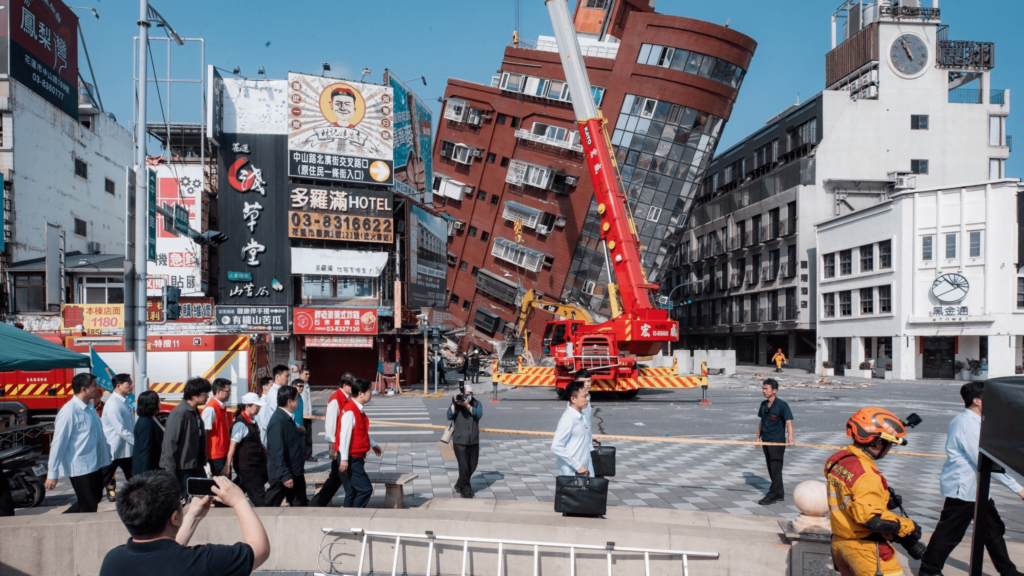Taiwan Earthquake: Resulting in the collapse of multiple buildings and trapping people inside. Taiwan, Japan, and the Philippines have all issued tsunami warnings to safeguard their citizens.

On Wednesday morning, Taipei, Taiwan experienced a significant seismic event, as a powerful 7.4-magnitude earthquake occurred off the east coast. Tragically, nine individuals lost their lives, and the Taiwan fire department reports at least 963 injuries. This seismic event, the strongest in a quarter-century for Taiwan, triggered numerous aftershocks and inflicted substantial damage on buildings while also causing landslides. Additionally, the tremors were felt in parts of China, highlighting the earthquake’s regional impact.
Summary:
- Nine fatalities and over 900 injuries were reported in Taiwan earthquake.
- Approximately fifty individuals missing, including those traveling on minibuses to a national park.
- Epicenter is situated off Taiwan’s sparsely populated east coast.
- Communication networks were severely disrupted.
According to Taiwanese media reports, fire safety officials have confirmed nine fatalities in Hualien County, which include three hikers and one engineering worker who were hit by falling rocks while on a trail. Additionally, at least 946 individuals have been reported injured.
Rescue operations are underway, with teams focusing on freeing approximately 137 people trapped in rubble or requiring rescue.
Since the initial earthquake, Taiwan has experienced over 100 aftershocks, creating a sense of unease among its roughly 23 million residents.
The National Fire Agency reported that authorities have lost communication with 50 individuals who were traveling in minibuses after the earthquake disrupted phone networks.
In Taipei, the capital, vehicles stopped on the roadside, and the city’s subway service was briefly halted. The earthquake caused tiles to fall from older buildings and furniture to topple due to its force.
Striking at a depth of 15.5 km (9.6 miles), the earthquake occurred during the morning rush hour as people were commuting to work and school. As a result, a tsunami warning was issued for southern Japan and the Philippines, though it was subsequently lifted.
A bed-and-breakfast owner in Hualien City shared her experience of calming frightened guests during the earthquake.
Meanwhile, Chang Yu-lin, a 60-year-old hospital worker in Taipei, described the tremors as exceptionally strong. “It felt like the house was on the brink of toppling,” Chang recounted.

Wu Chien-fu, who heads Taiwan’s Seismological Center, stated that the recent earthquake is the most powerful to impact the island since the earthquake of 1999.
Taiwan Earthquake Record History:
- In 1935, Taiwan experienced its deadliest earthquake in recent history, striking near the island’s west coast. The Central Weather Administration reported that over 3,200 individuals lost their lives in the disaster. According to the U.S. Geological Survey, the Hsinchu Taichung earthquake measured a magnitude of 7.1, ranking it among the world’s deadliest earthquakes. The aftermath left over 12,000 people injured and destroyed tens of thousands of homes.
- Officials have noted that the recent earthquake on Wednesday was the most powerful since 1999, when a 7.6-magnitude tremor hit central Taiwan, claiming the lives of over 2,400 individuals. The Chi-Chi earthquake, as it came to be known, caused significant devastation, with more than 100,000 houses damaged or destroyed, according to the CWA. In response to this catastrophe, authorities implemented stricter building codes. Furthermore, city governments have initiated recent campaigns to upgrade older buildings to enhance their earthquake resistance.
- In 2016, a 6.4-magnitude earthquake struck southern Taiwan, resulting in the collapse of a 17-story building in the city of Tainan and claiming the lives of at least 116 individuals. The earthquake’s epicenter was located in Taiwan’s central mountain range, with Tainan bearing the brunt of the impact. The disaster disrupted water supply to numerous residents and caused a fissure in the ground.
Taiwan sits within the Pacific Ring of Fire, a tectonic belt responsible for approximately 90 percent of global earthquakes. This geographical positioning makes Taiwan susceptible to seismic activity, prompting the implementation of stringent building regulations and disaster preparedness initiatives aimed at minimizing casualties from earthquakes.
Despite Taiwan’s proactive measures, the earthquake alert system, designed to issue warnings minutes before seismic events, failed to activate prior to the recent quake. This unexpected failure raises concerns about the effectiveness and reliability of the alert system in providing timely notifications to residents and authorities.
In light of this incident, there may be a heightened focus on enhancing the earthquake alert system’s functionality and reliability to ensure prompt and effective warnings in the event of future seismic activity. Such improvements could potentially mitigate the impact of earthquakes on Taiwan’s population and infrastructure, further reinforcing the island’s commitment to disaster preparedness and public safety.

Following tsunami warnings issued for Taiwan, Japan, and the Philippines, the Pacific Tsunami Warning Center in Hawaii, United States, declared that the threat had subsided. Fortunately, there were no reports of damage or casualties resulting from waves triggered by the earthquake.
The Japan Meteorological Agency also lifted all tsunami advisories after initially urging residents on the islands of Okinawa, Miyakojima, and Yaeyama to evacuate, citing the potential for waves as high as 3 meters (9.8 feet). Despite this warning, only a wave measuring about 0.3 meters (1 foot) high was detected on the coast of Yonaguni island approximately 15 minutes after the earthquake.
In response to the tsunami alert, Okinawa’s main airport suspended flights temporarily as a precautionary measure. Fortunately, the situation remained relatively calm, with no significant impact observed from the earthquake-generated waves.
According to Taiwan’s weather officials, the earthquake that struck Hualien on Wednesday was classified as “Upper 6”, signifying the second-highest level of intensity on a scale ranging from 1 to 7.
Quakes of this magnitude have the potential to cause significant damage, including the collapse of walls, particularly if they are not constructed with reinforced concrete blocks. Moreover, experts note that during such intense earthquakes, individuals may find it difficult to remain upright and may need to crawl in order to move safely.

The Psychology of Love: Why Valentines Day Matters More Epic Than You Think
Discover the psychology of love and why Valentines Day is more important than you think. Learn how love impacts the brain, strengthens relationships, and boosts

Premier League Highlights: Arsenal Humiliate Man City 5-1, Spurs and Palace Secure Crucial Wins
Arsenal demolished Manchester City 5-1 in a statement premier league highlights win, reigniting their title hopes. Meanwhile, Crystal Palace stunned Man United 2-0, and Tottenham

How Budget 2025 Impacts the Indian Middle-Class: Major Tax Benefits and Glaring Omissions
Budget 2025 offers major tax relief to the middle class, including zero tax on incomes up to ₹12 lakh. However, it misses out on incentives
